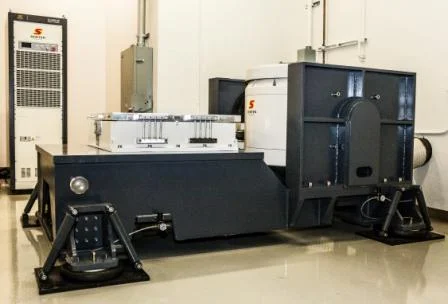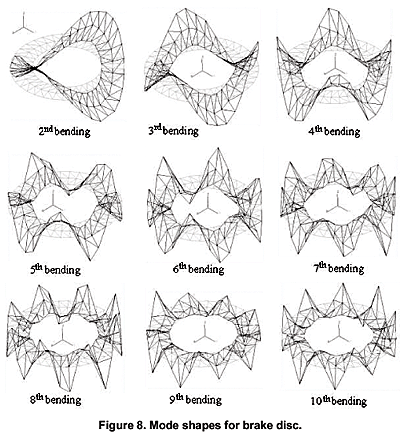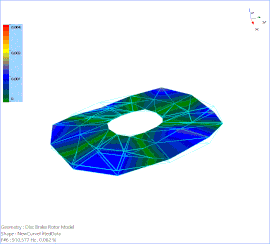Executing the modal analysis of a structure is crucial in order to analyze the modal parameters of a test object. The natural frequencies, damping and mode shapes of the unit under test provides help to adjust the mechanical properties of a structure by optimizing the design and improving the structural behavior of the test unit. Consequently, modal analysis is a critical part of product development.
This article examines the acquisition of modal characteristics from a disc brake rotor by performing experimental modal analysis. Brake systems are required for safe vehicle operation. The major component of a brake system is the disc brake rotor. While braking, the excitation frequency level can match natural frequencies and this phenomenon of resonance can cause the brake to squeal, potentially generating unpleasant vibration and noise. The resulting effects to the passengers’ ride and comfort must be examined, hence the execution of modal analysis is vitally important.
A hammer impact test is carried out using a modal hammer and 3 uni-axial sensors to obtain the vibration characteristics of a disc brake rotor. The short pulse induced with a modal hammer excites a wide range of frequencies. Another advantage of a hammer impact test is the quick and easy setup process. The modal test is carried out with a roving excitation method to avoid the mass loading effect induced with a roving response measurement.
The efficient Spider-80X vibration controller is used to execute the modal test. The latest 9.1 release of the EDM Modal software is used to execute the hammer impact modal test.
Figure 1. Modal Hammer Testing of the disc brake rotor
A mesh configuration of 39 measurement points is distributed radially and circumferentially over the disc brake rotor to obtain a good spatial resolution for the mode shapes. Using a flexible band and bungee cord, the brake disc is hung to imitate a free-free boundary condition (as shown in the experimental setup). A modal hammer with a metal tip is roved through the various measurement points. The responses to the impact excitations are captured using 3 uni-axial accelerometers that are placed accordingly. Measuring the excitation and response in the vertical direction facilitates the procurement of “out-of-plane” mode shapes.
Figure 2. Disc Brake Rotor Geometry
For this modal test, the modes up to 4th order bending are of interest and therefore a sampling rate of 8 kHz is set. A block size of 32768 is selected. A fine frequency resolution of 0.2441 Hz is produced with these configuration settings. Measurements of higher accuracy and reduced noise are obtained by linearly averaging 3 blocks of data at each measurement DOF.
The broadband spectrum from the metal tip on a modal hammer assists in exciting the modes up to a frequency range of 3.5 kHz. The large block size implemented helps ensure a natural decay of the structure response without introducing a conventional force-exponential window. Another added advantage of this block size is a finer frequency resolution. With this setup, there is no leakage, and a uniform window can be selected.
Figure 3. Hammer Impact Measurement of the disc brake rotor
The coherence plot helps users validate the measurement results; it looks good from the preceding screenshot. The valleys in the coherence plot occur at the anti-resonances which indicates that the response level is relatively lower at these corresponding frequencies. So overall, the inputs and outputs are well correlated in the desirable frequency range.
The DOF of the excitation and response for the measured FRF signals are switched automatically during roving excitation testing. This can be observed from the Modal Data Selection tab.
The FRF measurement displays good dominant peaks in the 0-3500 Hz frequency band. Overlapping the 117 measured FRFs, several modes can be identified. The good alignment of these peaks indicates good measurement results, and no mass loading effect was induced.
Figure 4. Modal Data Selection tab showing the magnitude and phase part of all overlapped FRFs
The Complex Mode Indicator Function (CMIF) is used to locate modes in the desired frequency range. In addition, the summed FRF is also observed to identify the modes. The new Poly-X method is used to curve-fit the FRF’s to procure the following stability diagram. Six flexible modes are selected within the desired frequency range.
Figure 5. Mode Indicator Functions to locate and identify the modes in the desired frequency range
The stable poles (stable frequency and stable damping) are selected to obtain the natural frequencies and the damping ratios of the interested modes. The residue calculation facilitates in obtaining the mode shapes associated for each of the modes.
Two referenced articles (FEA and Experimental Modal Surveys) on the modal analysis of disc brakes are studied to analyze and compare the in-plane modes and out-of-plane bending modes with the obtained results.
Figure 6. Referenced articles displaying some of the in-plane modes and out-of-plane bending modes of the disc brake rotor.
The Auto-MAC matrix helps users validate the results. The Auto-MAC matrix below shows users that the modes are orthogonal to each other (low off-diagonal elements) and are uniquely identified (high diagonal elements).
Figure 7. Auto-MAC chart for the identified modes
Figure 8. 2nd Order Bending Mode of the Disc Brake Rotor at 334 Hz
Figure 9. Shifted 2nd Order Bending Mode of the Disc Brake Rotor at 347 Hz
Figures 8 and 9 show the shift in the 2nd order bending mode of the disc brake rotor.
Figure 10. 1st In-Plane Mode of the Disc Brake Rotor at 680 Hz
Figure 12. 3rd Order Bending Mode of the Disc Brake Rotor at 910 Hz
Figure 14. Shifted 3rd In-Plane Mode of the Disc Brake Rotor at 1182 Hz
Figure 11. 2nd In-Plane Mode of the Disc Brake Rotor at 682 Hz
Figure 13. 3rd In-Plane Mode of the Disc Brake Rotor at 1167 Hz
Figures 13 and 14 show the shift in the 3rd in-plane mode of the disc brake rotor.
The shift in the bending modes and in-plane modes is because the repeated roots of the symmetric circular disc are identified.
Figure 15. 4th In-Plane Mode of the Disc Brake Rotor at 1190 Hz
Figure 16. 4th Order Bending Mode of the Disc Brake Rotor at 1687 Hz
The modal analysis results match well with the referenced FEA and Experimental modal surveys carried out on other disc brake rotor models. The results emphasize the strength of the Spider-80X DAQ system and the efficiency of EDM Modal software to execute sophisticated modal tests on intricate structures.
To learn more about EDM Modal software, visit: www.crystalinstruments.com/edm-modal-testing-and-analysis-software/


















